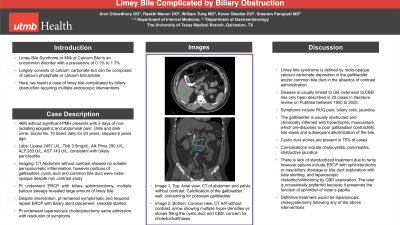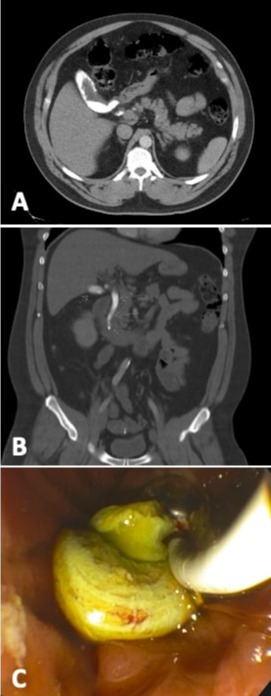Sunday Poster Session
Category: Biliary/Pancreas
P0084 - Limey Bile Complicated by Pancreatitis and Biliary Obstruction
Sunday, October 22, 2023
3:30 PM - 7:00 PM PT
Location: Exhibit Hall

Has Audio

Anni Chowdhury, DO
University of Texas Medical Branch
Galveston, TX
Presenting Author(s)
Anni Chowdhury, DO1, Raakhi Menon, DO1, Kinan Obeidat, MD1, Sreeram Parupudi, MD1, William Tung, MD2
1University of Texas Medical Branch, Galveston, TX; 2UTMB, Galveston, TX
Introduction: Limey bile syndrome (LBS) or milk of calcium bile is an uncommon disorder, with a prevalence of only 0.1% to 1.7%. In LBS, the gallbladder or biliary canaliculi are filled thick, pasty bile largely consisting of calcium carbonate, which can cause cholecystitis or biliary colic. Here we describe a case of limey bile causing pancreatitis and biliary obstruction requiring recurrent endoscopic interventions. Both of these independently are lesser seen complications of LBS, but in conjunction with each other is exceedingly rare.
Case Description/Methods: 46 year old male with without significant past medical history presents with five days of non-radiating epigastric and abdominal pain, chills and dark urine. Social history was notable for daily alcohol use of 10 beers for over 20 years however, last drink was 6 years ago. Initial labs notable for Lipase 2457 U/L, total bilirubin 3.5mg/dL, alkaline phosphatase 290 U/L, ALT 283 U/L, AST 143 U/L, consistent with biliary pancreatitis. CT of abdomen was not notable for significant peri-pancreatic inflammation, although there were radio-opaque portions of gallbladder, cystic duct, and common bile duct despite non-contrast study. He underwent endoscopic retrograde cholangiopancreatography (ERCP) with biliary sphincterotomy. Multiple balloon sweeps revealed large amount of limy bile. Patient remained symptomatic post procedure and subsequently due to labs indicating worsening biliary obstruction, repeat ERCP done for biliary stent placement. He also underwent laparoscopic cholecystectomy same admission with resolution of symptoms.
Discussion: LBS defined by radio-opaque calcium carbonate deposition in the gallbladder and/or common bile duct in the absence of contrast administration. The gallbladder is usually obstructed and chronically inflamed with hypertrophic musculature which pre-disposes to poor gallbladder contractility, bile stasis and subsequent alkalinization of the bile. It can cause biliary colic and cholecystitis however it can rarely result in biliary obstruction and pancreatitis. In literature review, only 20 other cases of LBS with extension into the CBD from 1955 to 2020 have been described. This condition lacks standardized treatment however ERCP with sphincterotomy is preferred. Other options include ERCP with nasobiliary drainage or bile duct exploration with tube stenting, and laparoscopic choledocholithotomy by CBD exploration. Definitive treatment would be laparoscopic cholecystectomy following any of the above interventions.

Disclosures:
Anni Chowdhury, DO1, Raakhi Menon, DO1, Kinan Obeidat, MD1, Sreeram Parupudi, MD1, William Tung, MD2. P0084 - Limey Bile Complicated by Pancreatitis and Biliary Obstruction, ACG 2023 Annual Scientific Meeting Abstracts. Vancouver, BC, Canada: American College of Gastroenterology.
1University of Texas Medical Branch, Galveston, TX; 2UTMB, Galveston, TX
Introduction: Limey bile syndrome (LBS) or milk of calcium bile is an uncommon disorder, with a prevalence of only 0.1% to 1.7%. In LBS, the gallbladder or biliary canaliculi are filled thick, pasty bile largely consisting of calcium carbonate, which can cause cholecystitis or biliary colic. Here we describe a case of limey bile causing pancreatitis and biliary obstruction requiring recurrent endoscopic interventions. Both of these independently are lesser seen complications of LBS, but in conjunction with each other is exceedingly rare.
Case Description/Methods: 46 year old male with without significant past medical history presents with five days of non-radiating epigastric and abdominal pain, chills and dark urine. Social history was notable for daily alcohol use of 10 beers for over 20 years however, last drink was 6 years ago. Initial labs notable for Lipase 2457 U/L, total bilirubin 3.5mg/dL, alkaline phosphatase 290 U/L, ALT 283 U/L, AST 143 U/L, consistent with biliary pancreatitis. CT of abdomen was not notable for significant peri-pancreatic inflammation, although there were radio-opaque portions of gallbladder, cystic duct, and common bile duct despite non-contrast study. He underwent endoscopic retrograde cholangiopancreatography (ERCP) with biliary sphincterotomy. Multiple balloon sweeps revealed large amount of limy bile. Patient remained symptomatic post procedure and subsequently due to labs indicating worsening biliary obstruction, repeat ERCP done for biliary stent placement. He also underwent laparoscopic cholecystectomy same admission with resolution of symptoms.
Discussion: LBS defined by radio-opaque calcium carbonate deposition in the gallbladder and/or common bile duct in the absence of contrast administration. The gallbladder is usually obstructed and chronically inflamed with hypertrophic musculature which pre-disposes to poor gallbladder contractility, bile stasis and subsequent alkalinization of the bile. It can cause biliary colic and cholecystitis however it can rarely result in biliary obstruction and pancreatitis. In literature review, only 20 other cases of LBS with extension into the CBD from 1955 to 2020 have been described. This condition lacks standardized treatment however ERCP with sphincterotomy is preferred. Other options include ERCP with nasobiliary drainage or bile duct exploration with tube stenting, and laparoscopic choledocholithotomy by CBD exploration. Definitive treatment would be laparoscopic cholecystectomy following any of the above interventions.

Figure: Image A: Axial view, CT of abdomen and pelvis without contrast. Calcification of the gallbladder wall, concerning for porcelain gallbladder
Image B: Coronal view, CT A/P without contrast, arrow showing multiple hyper-densities vs stones filling the cystic duct and CBD, concern for choledocholithiasis
Image C: Endoscopic view of Limey bile during balloon sweep
Image B: Coronal view, CT A/P without contrast, arrow showing multiple hyper-densities vs stones filling the cystic duct and CBD, concern for choledocholithiasis
Image C: Endoscopic view of Limey bile during balloon sweep
Disclosures:
Anni Chowdhury indicated no relevant financial relationships.
Raakhi Menon indicated no relevant financial relationships.
Kinan Obeidat indicated no relevant financial relationships.
Sreeram Parupudi indicated no relevant financial relationships.
William Tung indicated no relevant financial relationships.
Anni Chowdhury, DO1, Raakhi Menon, DO1, Kinan Obeidat, MD1, Sreeram Parupudi, MD1, William Tung, MD2. P0084 - Limey Bile Complicated by Pancreatitis and Biliary Obstruction, ACG 2023 Annual Scientific Meeting Abstracts. Vancouver, BC, Canada: American College of Gastroenterology.
